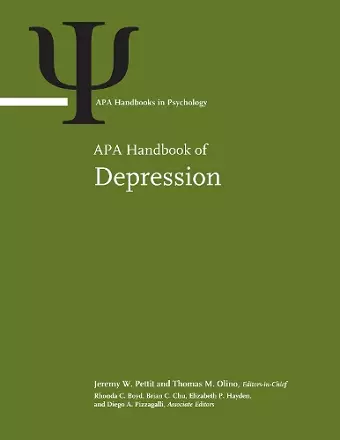APA Handbook of Depression
Volume 1: Classification, Co-Occurring Conditions, and Etiological Processes; Volume 2: Minoritized Populations, Lifespan Development, Assessment, and Treatment
Diego A Pizzagalli editor Jeremy W Pettit editor Brian C Chu editor Thomas M Olino editor Rhonda C Boyd editor P Elizabeth Hayden editor
Format:Set / collection
Publisher:American Psychological Association
Publishing:31st Dec '25
£411.00
This title is due to be published on 31st December, and will be despatched as soon as possible.

This comprehensive two-volume handbook provides an authoritative, robust examination of current information on depression.
Depression is a leading cause of disability, a major contributor to global disease burden, and one of the most commonly presenting problems in mental health and primary care settings. Its pervasive impact on individuals, families, and communities underscores the urgency of advancing understanding and treatment of this complex mental health condition. The APA Handbook of Depression reflects the critical need for a comprehensive resource that highlights advancements, presents up-to-date knowledge, and provides mental health professionals with a robust foundation for clinical practice, research, and education. The 75 chapters in the handbook represent the collective efforts of leaders in the field, spanning diverse disciplines and perspectives, and reflecting a rich tapestry of expertise within depression research and practice. Chapter contributors synthesized the latest research findings and clinical insights into a compendium that contextualizes the breadth and depth of basic and applied research on depression within diverse populations and developmental periods, while also identifying critical directions for future research.
Volume 1 contains four parts focusing on classification, epidemiology, co-occurring conditions, and etiological processes of depression. Part 1 delves into the historical context of depression, diagnostic classification, epidemiological trends, and the burden of co-occurring conditions such as anxiety disorders, substance use disorders, and trauma-related disorders, among others. Part 2 explores multiple biological contributors to depression, from molecular genetics to brain structure and function to psychophysiology and neuroimmune interactions. Part 2 further delves into behavioral genetics, animal models of depression, and the role of sleep and circadian rhythms in depression. Part 3 examines individual differences and psychological processes, including temperament, attachment, stress reactivity, self-regulation, and reward processing. Part 3 also considers learning and cognition in depression, including attention, interpretation, cognitive control, and memory. Finally, Part 4 covers social and cultural processes in depression, including interpersonal relationships, community, and cultural processes. Part 4 also addresses depression-related stigma and the increasing relevance of technology to depression. In Volume 2, the focus shifts to depression in historically marginalized populations, depression across the lifespan, and assessment, prevention, and treatment of depression. Part 1 highlights the unique challenges faced by diverse populations and minoritized groups. Part 2 addresses depression across different developmental stages, from...
ISBN: 9781433843310
Dimensions: unknown
Weight: unknown
1437 pages